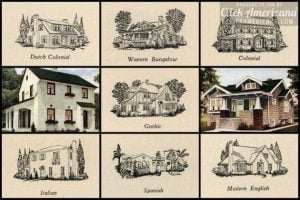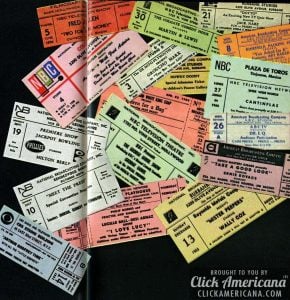The popular collectibles first set sail from 18th-century England — to be precise, from the workshops of artistic Staffordshire potters.

Another type of British invasion: Toby jugs
These quirky jugs managed to hop onto the ship of American culture not long after they’d won hearts in their home country. Crossing the mighty Atlantic, they found themselves a cozy spot in the homes and hearts of the American people around the Revolutionary War era.
In the process, the designs evolved, started reflecting the changing times, the American essence, the heroes, the villains, and the icons of every era.

Toby mugs & popular culture
Suddenly, it wasn’t just about the jolly old man in the tricorn hat anymore. Toby mugs started featuring popular figures of American culture — an echo of the nation’s heart and mind, frozen in porcelain.
Political figures, sports icons, even fictional characters started making appearances, and from Uncle Sam to Babe Ruth, Superman to Elvis Presley, every jug was like a 3D caricature, marking the changing trends of American society. (That’s not even to mention the changes to British society — various versions of Doctor Who have shown up on Tobys.)

Toby jug influence has extended beyond the realm of art and history, even taking a spotlight in popular culture, when a Toby collection figured prominently in the plotline of one episode of the Bravo TV series Imposters.
This brush with the glitz and glamour of the small screen has only boosted the Toby jug’s reputation. Their little porcelain faces have almost become symbols of Americana, painting a unique picture of the United States’ cultural landscape thorough the years.
Take a look at the various Toby jug photos we’ve collected below, dating from the 1700s onward — along with a fascinating retrospective published in 1913 (long before Elvis and Donald Duck Toby mugs existed!).

What is a Toby jug?
Take a virtual tour of the American Toby Jug Museum in Evanston, Illinois
“The American Toby Jug Museum is the world’s largest collection of Toby Jugs — bizarre character jugs with a history that spans hundreds of years, but its primary origin began in the mid-1700s. Steve Mullins started this Toby Jug collection in 1947, and today the museum houses a collection of over 8,000 Toby Jugs — that includes the largest, smallest, and oldest Toby Jugs on Earth.”

The picturesque Toby jug (1913)
By Mary H Northend for American Homes and Gardens (March 1913)
Of all antiques that form collections, nothing to my mind is more interesting than the squat, fat little Toby, with its bright coloring and ever recurring mug. This quaint little figure is always fascinating, for in imagination it transports one inside the old ale houses or chop houses where, gathered around the table, is seen a group of men, each one drinking from one of these queer little mugs.

Those of today are made generally in Germany, but their ancestors, the original Tobies, came from England, although little regarding them is to be found in the published authorities of British ceramic wares.
Fortunately, research in old registers enable one to get a few exact dates concerning them and their origin. Most of them are old Staffordshire and are not marked by any maker’s name, but they have such distinctive modeling and coloring, that they may be easily distinguished from the modern [1900s] reproductions, many of which are supplied from Holland and France.

Toby jugs, in the latter part of the eighteenth century and the early part of the nineteenth, were adapted to cartoons and convivial qualities of hero worship. They were fitted with likenesses of great men, giving us Wellington, Drake, General Howe, and Lord Nelson hollowed into ale mugs.

Among them, too, Napoleon was found, made in France. The reason it is thought to have been made in that country is from the fact that the likeness of The Little Corporal is not a caricature.
English potters delighted to depict Bonaparte, but they seldom gave him the attractive countenance of this jug. They made him tall and thin, or short and abnormally fat, and dressed him in queer clothes, labelling him, “Bony.”
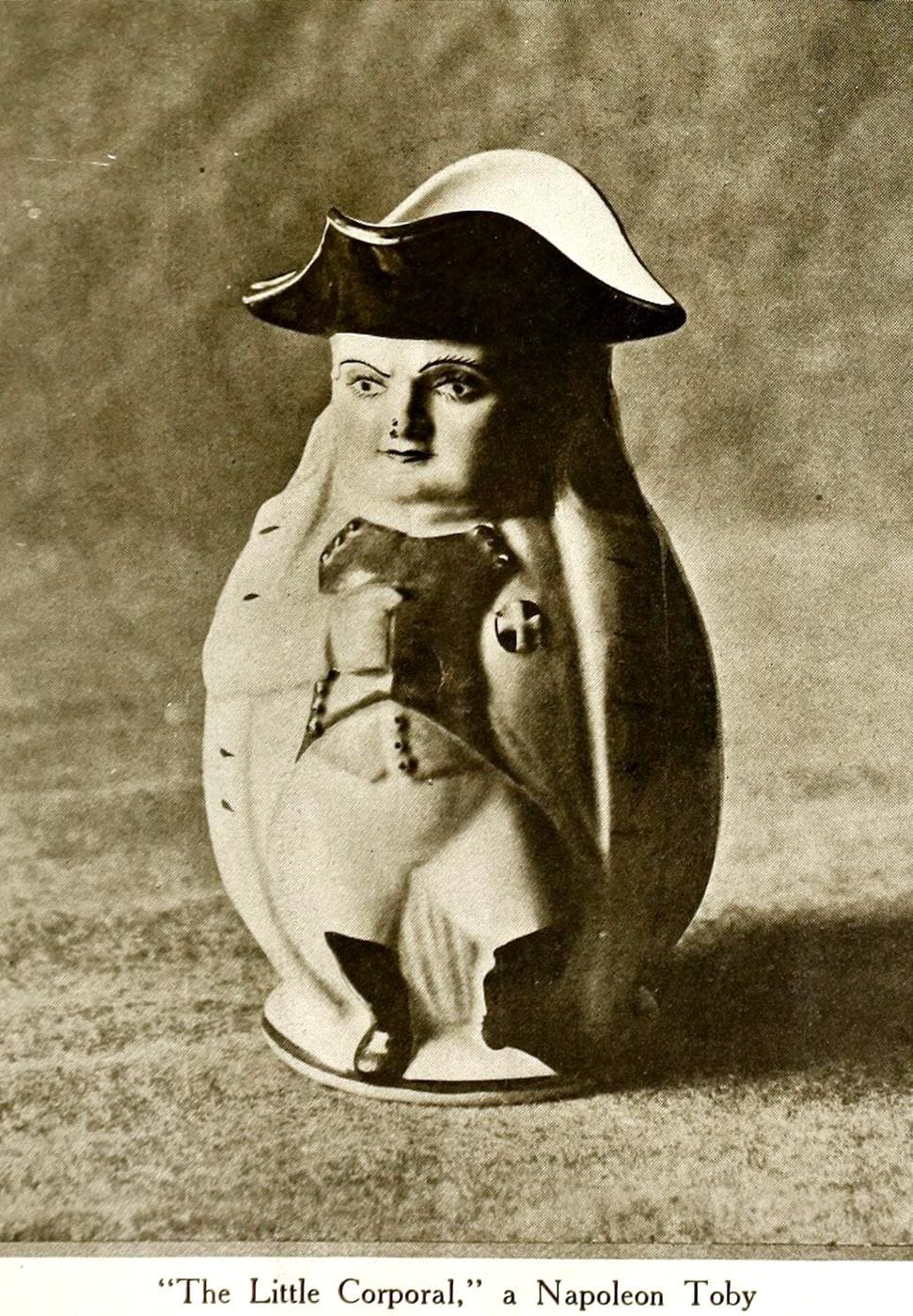
This jug, owned by Mr. Seth F. Low, of Salem, Massachusetts, is in very pleasant guise, suave of countenance, and very well dressed. There is a smoothness of texture about the work that marks it as distinct from the English Tobies, which unfortunately frequently lack these desirable qualities.
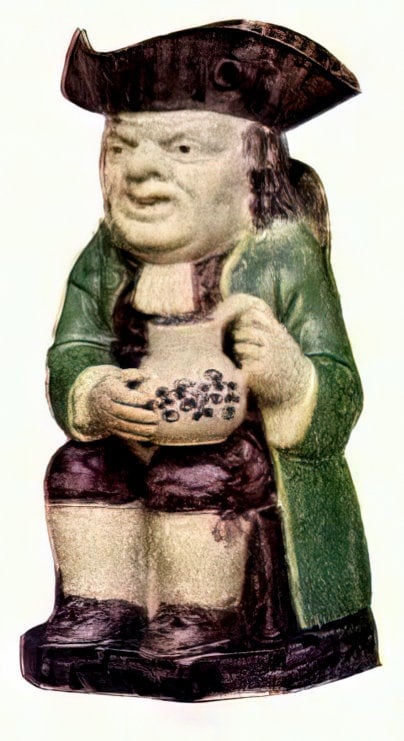
Why are they called Toby jugs?
The name “Toby,” so the legend runs, was derived from “Uncle Toby,” a character in “Tristram Shandy.” Whether this is true or not, this little drinking mug was in favor at the time of the coming out of Sterne’s novel.
These were not the first of the kind, for before the advent of the real Toby, a stoneware jug was made by Flemish potters in the early part of the seventeenth century, and, no doubt, was put to the same use that the Toby eventually served.

These jugs were called “Greybeards,” or “Bllarmines.” These names were given in derision of an unpopular Cardinal of the times, the bearded face being a caricature. Every one that was made, boasted a generous rotundity of outline with two fat arms and hands that made a futile attempt to clasp each other across the well-filled-out waistcoat, while directly under a plain band that finished the top was a face with flowing beard.

As early as 1750, and even before, we find these mugs, showing rummy, old red-nosed faces, with always their drinking mug in hand. They were supposed to have been invented by one Toby Philpott of jovial nature, and the original jug was supposed to be his portrait.
SEE MORE… Antique buttons: How to identify these exquisite collectible treasures (18th & 19th centuries)
The first Tobies were in reality scarcely more than hollow figures, to which a handle had been attached, but as time went on, they grew more and more like mugs and while at first the cap or hat lifted off, forming a cover, the succeeding style had the hat incorporated into the mug, forming the lip. They were gayly dressed in vivid colors, ranging from twelve to fourteen inches in height.

England has the honor of making the Toby an institution. They are shown in a considerable variety of modeling and decoration. The first ones were brightly colored, formed like a man, seated, and holding his pipe or ale mug in his hand.
They have, from the commencement, shown different designs, some of them being full length as the Jolly Good Fellow. These drinking mugs were made in many factories, those at Bennington, Vermont, being the only ones that bear a distinctive mark and in consequence are more highly prized by connoisseurs.

A unique specimen that was made in this factory is the only one that shows no mug in the hand, the arms being arranged closely to the body and giving the appearance of having no arms at all.
A genuine Toby of the late eighteenth century costs anywhere from $50 to $75 [in 1913 dollars], while much higher prices are commanded by some of the rarer kinds. They are shown in all moods, some being jovial in appearance, others placid, and still more are leering. In fact, every kind of a Toby is represented, except a dry one.

In addition to depicting the figures of human beings, there are some Tobies, although rare, that represent animals, while not a few are in the form of tea pots. These latter are generally finished in blue with a band of green and a bit of copper luster. They vary in height from twelve to eighteen inches.
Among the Tobies which have been made with noted likenesses are those of George II and George IV, the former being very unpopular with the tavern folk. He was endowed with a greedy-eyed, heavy-jowled countenance, yet showing a caricature of the original which makes the likeness unmistakable. The Staffordshire modeler who designed George IV did it with little appreciation of his subject, however.

There is a quaintness and fascination about these little mugs or pitcher men, that a collector cannot resist. It requires great patience and no small amount of “old-timey” things, when Tobies had outlived their days of usefulness, no further thought was given to them, and they were unheeded and lost track of.

Not a few of them were considered of so little consequence that they were relegated to the dump heap, so that when the fad for collecting them received an impetus, the collector encountered no little difficulty in securing them, for while there seemed to be an abundance of the queer-fashioned mugs on the market, it was not hard to determine that the greater part of the specimens exhibited were modern reproductions rather than the genuine old-time Tobies.

The identification of an original naturally requires both time and skill, but that is a part of the collector’s education, and he soon learns the real points, buying with judgment and often selling for far more than the specimen costs.
To the novice, let it be said that the modern affairs are so realistic of newness that they are easily detected, for while they imitate as far as possible the new ideas, yet they come under a far different category. They have not the same soft colors of the originals, and as they are handled, the old jug is found to be much lighter than the new.
Then, too, more especially in the Ralph Wood figures, part of the glaze appears to be missing. By passing a lead pencil over the surface, a place will be found where the pencil grates and leaves a mark, and this should be observed by every collector.

English Tobies are sometimes classified as Young and Old Tobies, and the terms are expressive, for the Young Toby is a figure standing as if full of life and vigor, with a jovial, happy-go-lucky expression.
The Old Toby is represented as seated, with a worldly wise face which conveys an impression of having experienced life to the fullest. Both types always carry the mug in one hand or in both hands, and from it a foaming liquid seems about to issue. The coloring of the Old Tobies is principally yellow, while that of the Young ones, is a combination of brown and yellow. Of course both these colorings are varied with others.

In 1716 a son was born to a Staffordshire miller, who was named Ralph Wood. He became a potter, and he in turn had a son named Ralph, who followed the same occupation. This man had a son who was the third to be called Ralph Wood, and this last named Wood went into the same business with his father’s cousin, Enoch Wood, who was dubbed, “The Father of Pottery,” and the whole family help us much in the study of Staffordshire figures.
The two characteristics of the Woods’ figures were that the coloring is extremely delicate and that the flesh tints were of a pale, fawnish gray color, rarely if ever of the usual flesh-tints. They were the first, probably, to make Toby Philpotts, as they were called. Other potters took up the same craft and led to a flood of these little jugs. Even the great Wedgewood himself is known to have made some.
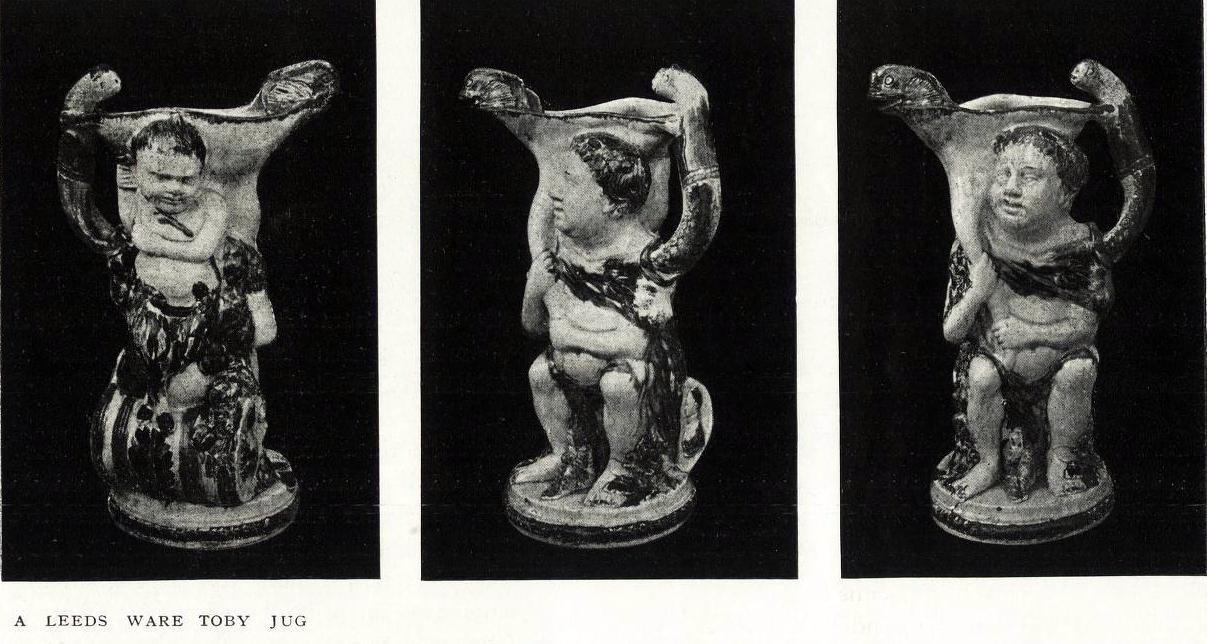
These figures lasted for a century and a half and were very fashionable during that period. One of the earliest ever made in Staffordshire has a daub of dark brown magnus on the eyes, and the whole contour of the figure suggests that it was one of the earliest made.
Toby jugs and many figures are still made in Staftordshire, notably at Longton. They sell for a shilling or so, but do not have the soft colors of the old work.
It is not difficult now to buy these old Staffordshire figures, but the prices are much more than they are worth, and are liable to go still higher as the demand for these quaint ornaments increases. The day has passed when these were neglected by the children who were tired of them and desired something new and who had no regrets regarding their sale until they realized that they could have obtained pounds where they formerly received shillings.

This is due to the small army of collectors who had the craze and were strong on the trail of antiques. While not belonging to the Staffordshire period, yet there was a kind of ware that was known as the Sunderland ware, which was rose pink.
Some of this was made into jugs depicting the Rollicking Sailor, Masonic emblems, and wedding symbols, the last sometimes hearing the name of both bride and groom. These ranged in sizes from a gill to a gallon.

One of the most popular of the Sunderland productions was the Frog Mug. This had a band of coloring on the outside and to all appearances was a china mug. Inside, however, was the figure of a frog, bearing the proper coloring, generally crawling up the side, but sometimes on the bottom of the inside.
These are very rare, and one of the best specimens is owned by Mrs David P. Page, of Newburyport, Massachusetts.

There was an object in the making of these mugs, for when filled to the brim, the frog was concealed. It was a favorite trick of the innkeeper or of some of the many friends gathered for a convivial drink, to hand one of these mugs, filled, to the innocent victim.
Raising the foaming ale to his lips, the unfortunate one would drink deeply only to be startled by the appearance of a frog’s head beneath the foam. Sometimes the deception was so real that it was almost an impossibility to make the drinker realize the joke.

With the revival of cottage ornaments, both old and new, the Toby comes into play. In more elaborate form, it is often a chimney ornament, a reminder of the olden days rather than an actual drinking vessel. Many of them are today as bright in coloring as they were when they came from the Staffordshire potteries so long ago.
They are, frankly speaking, drinking mugs, some of them illustrating bear mugs and jugs and are made in astonishing variety. Few resemble one another enough to make a real pair, and in fact when made in sets, they are often colored differently to give variety.

Some of the best specimens are equal to the old colored statuettes. They were made by potters of renown who gave them great care. Among them were prominent the Shepherd Plaid; the Drinking Parson, with his flowing white hair; the Watchman, seated with his lantern between his knees; the Sailor, standing by the side of a tree, one bough of which forms the handle, and many other quaint varieties.

American Tobies were also made. Some of them made at Bennington are of a peculiar mottled brown and are considered very good. The most distinguished of these show likenesses of Washington, Ethan Allen and Ben Franklin. The pottery was discontinued in 1849.

The quaint gay colored bits that were once so profusely made but which, with the lapse of time, have disappeared, are today comparatively few. They stand prominently among collectors’ interest as the most convivial of all drinking vessels — called “Toby” from the thirsty old soul who invented them.

Many of them are most genial in appearance, while others have disagreeable leering faces which should, under ordinary circumstances, dispel the drinker from partaking of his social glass of foaming beer from one of these odd, picturesque old mugs.

Gabriel Varden, so Dickens tells us, drank out of just such a mug as this, replenished constantly by the hand of Dolly Varden, who sat near him at table. Maybe the jug from which he drank was a Staffordshire one, gay with its red coat and its green trousers, for the Staffordshire Jugs show more brilliant coloring than any others.
Probably the most prominent of all these makers and designers of Tobies was Ralph Wood, whose colorings, mentioned before, were extremely delicate. Of course, there were other potters who took to figure making, which resulted in a deluge of this kind of drinking mug.

Commencing with the great Wedgewood himself, who started this work before he fell in love with the Greek school of statuary, we descend to such men as Voyez, Neale, Wood, and Caldwell, Bott and Company, Wilson, Lakin, Poole, and Walton. From many of these men we have marked pieces, although few tobies are thus designated.
Davenport’s name occurs most often on Toby jugs, some of which are shown in rare collections in the museums of all parts of England.

Very few tobies are found today in silver luster. They are most unique and almost impossible to decipher, as the faces are not as good and clear as in the china jugs. Two of these are in the Atkinson collection at Salem, Massachusetts, while another well-known Toby of this make is carefully treasured in a collection at New Orleans, La. There are also some that are made in gold luster, very plain and without ornamentation.
A few of this ware are to be found even in the most prolific collectors’ treasures, showing that they are very limited in make. The most prolific are the Staffordshire ones, and their age can easily be determined, for even the most careless observer cannot be deceived in those which are distinguished by having no caps.

There are many English Tobies, however, that have been so cleverly imitated that it is dificult for even an old collector of china to be absolutely sure as to which are old and which new.
One of the tobies most interesting to Amaricans is the Benjamin Franklin one. Some of this kind are still to be found in Philadelphia. They are generally large and show the distinguished gentleman taking snuff, the year of its make dating back probably from ninety to a hundred years.
Roughly speaking, the Staffordshire figure, from a collector’s point of view, lasted about a century and a half — that is, from the last quarter of the seventeenth to and including the first quarter of the nineteenth.

A learned and enthusiastic collector has suggested that these figures should be divided into no less than nine sections. In subordination to the same idea is a possibility of classifying the time named into four periods of nearly equal duration which the ordinary collector may readily master. It is but a rough division which is subject to overlapping by potters, modellers, and pieces.
In the first division we should have the Slip specimens, including Astbury figures. In the second, Ralph Wood, Thomas Whieldon, and others. In the third we have Josiah Wedgewood, Ralph Wood, Potter Number Two, Lakin, and Enoch Wood. In the fourth comes Walton, Wilson, Salt, and others.

This division may be a help to the collector in trying to distinguish periods, for the earliest Toby ever made in Staffordshire had a daub of dark brown “magnus,” and the whole contour suggests an initial time.
This type shows a figure sitting in a chair, holding a pitcher of foaming ale in one hand. He wears a cocked hat, with rosette on the left side, a wig of flowing curls reaching to his shoulders. He shows a jovial face and double chin, and is dressed in a white robe edged with buttons, which is open and shows a laced vest of white beneath. He also wears knee breeches and has little stubby legs with his feet encased in low shoes.

A most unusual and interesting group of Tobies is found in the Nathaniel Spofford collection at Salem, Massachusetts, each one of which is a correct imitation of an Irish lord.
The collection was carefully gathered, one at a time, until the number was complete. This group stands on a shelf in the dining room, with a background of Dutch blue, which attracts a great deal of favorable attention from everyone.

Each figure differs in shape and in modelling, and the most important one is that of a squatty old man, with heavy eyebrows, “mutton chop” whiskers, and cocked hat. His double chin reposes inside a high collar tied with a bow of bright color.
The waistcoat is of red and white, with red buttons, while the short black coat comes to the waist. The legs are much foreshortened and give a very squatty appearance. His hands are thrust into his pockets, and altogether he makes a very jovial caricature.

Another remarkable Toby in this collection is a short figure, sitting down, with very leering face which is emphasized by mustache and goatee.
We are very sure that jugs are made in England today that are similar to the old ones. They are very light and not made of the old creamy bone paste of long ago. Then, too, they are differently decorated, making such a vivid contrast that even an inexperienced person could tell the difference.
Few new ones [from around 1900], however, have crept into collectors’ possession. They are mostly odd ones that have been purchased either for their design or on account of some interesting feature about them.

The number which will be found possible to collect is indefinite and depends much upon the means of the buyer. They can be obtained principally in antique shops, and in buying the inexperienced collector must use great discretion, for the best specimens are of course very rare and have been acquired by eager connoisseurs long ago.
An antique Toby mug

An antique Toby mustard pot

Vintage 1940s Royal Doulton Cavalier Toby jug

Vintage Blondie actress Penny Singleton and her shelves with Toby jugs and mugs (1941)

Mr Pickwick & Sairey Gamp Doulton jugs (1948)

Vintage Royal Doulton 1950s Toby jugs (1952)

Vintage book – The Enchanted Toby Jug (1964)

DON’T MISS! Antique toys: See what kids played with a long time ago – and that people collect now
















